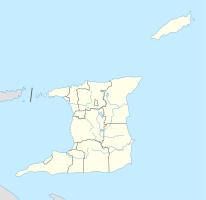Siparia (Trinidad)
| Siparia | ||
|---|---|---|
|
Coordinates: 10 ° 9 ′ N , 61 ° 30 ′ W Siparia on the map of Trinidad and Tobago
|
||
| Basic data | ||
| Country | Trinidad and Tobago | |
| region | Siparia | |
| Residents | 10,254 (2011) | |
| Detailed data | ||
| height | 73 m | |
| City structure | 3 communities | |
Siparia is a city in Trinidad and Tobago . It is the capital of the region of the same name and an administrative unit in the extreme southwest of Trinidad .
location
The Siparia region is formed by an elongated headland in the southwest of Trinidad. Within this region, Siparia is located in the middle of the inland on the eastern border with the Penal-Debe region . About 15 km further west is Point Fortin , about 15 km north-northeast of San Fernando . 8 km south is the Boca del Serpiente strait, which separates Trinidad from Venezuela, 10 km north is the Gulf of Paria . The city lies on a climatically favorable plateau.
history
The name and location of the place go back to an Arawak settlement. The first settlement by Europeans took place in 1758 by missionaries of the Capuchin order sent from Aragon . The Spanish governor José María Chacón tried during his tenure to settle Spaniards loyal to the king in Siparia. He did not have any lasting success with it; a British expedition under Frederick Mallet sent out after the conquest of Trinidad in 1797 counted only one Spaniard living in Siparia and 140 Indians. The British Governor Ralph Woodford resettled Spanish royalists in Siparia in 1813, this time refugees from the war of liberation in Venezuela . The Spaniards successfully grew cocoa and coffee and helped Siparia achieve a significant upswing, which came to an abrupt end with the abolition of slavery in 1834.
In the 19th century a statue of the patron saint of all South American Capuchin missions, La Divina Pastora, was erected in the church of Siparia and named after the patroness. In honor of the patron saint, the Siparia Fete is celebrated annually on the second Sunday after Easter , a one-day festival with music, a parade, bike races and a contest.
In 1913, oil was found in southwest Trinidad, which led to an economic boom in the city. Until 1990 Trinidad was divided into counties . Siparia developed into an administrative center within St. Patrick's county. As part of the territorial reform of 1990, it became the capital of the newly created Siparia region.
Economy and Transport
Siparia is dominated by agriculture. The city is crossed by the SS Erin Road, which connects Point Fortin with San Fernando. From 1913 to 1953 Siparia was connected to the then railway network of the Trinidad Government Railway.
Administration, politics and public institutions
Siparia is the seat of the Siparia Regional Corporation , the administrative body that manages the Siparia region .
The smallest administrative unit in Trinidad and Tobago is the "community", comparable to a city or district. Siparia is divided into 3 communities:
| Community | Residents |
|---|---|
| Siparia Proper | 6170 |
| Robert Hill / Siparia | 667 |
| Thick Village | 3417 |
| total | 10,254 |
Educational institutions in Siparia are the Iere High School and the Siparia West Secondary School. Religious institutions in Siparia are the La Divina Pastora RC Church (Roman Catholic) and the Siparia Open Bible Church (Pentecostal movement). There is a state-run hospital, a police station and a fire station.
There is a special feature with regard to the Roman Catholic La Divina Pastora RC Church: the statue of the Virgin Mary exhibited there is venerated by the Hindu community as an image of the goddess Lakshmi , so that the space is used by two religions.
Personalities
- John Mendes (1926-2005, Auxiliary Bishop in Port of Spain)
- Ian Morris (born 1961, athlete)
- Kamla Persad-Bissessar (* 1954, politician)
- Angelo Bissessarsingh (1982-2017, historian)
- Giselle Salandy (1987-2009, boxer)
Individual evidence
- ↑ Michael Anthony : Historical Dictionary of Trinidad and Tobago. Scarecrow Press 1997, p. 530.
- ↑ Michael Anthony: Towns and Villages of Trinidad and Tobago. Printmaster 2001, p. 300.
- ↑ History of PTSC. (No longer available online.) Archived from the original on April 10, 2013 ; Retrieved July 24, 2015 . Info: The archive link was inserted automatically and has not yet been checked. Please check the original and archive link according to the instructions and then remove this notice.
- ↑ Article of the CFCTT. (No longer available online.) Archived from the original on July 25, 2015 ; Retrieved July 24, 2015 . Info: The archive link was inserted automatically and has not yet been checked. Please check the original and archive link according to the instructions and then remove this notice.
